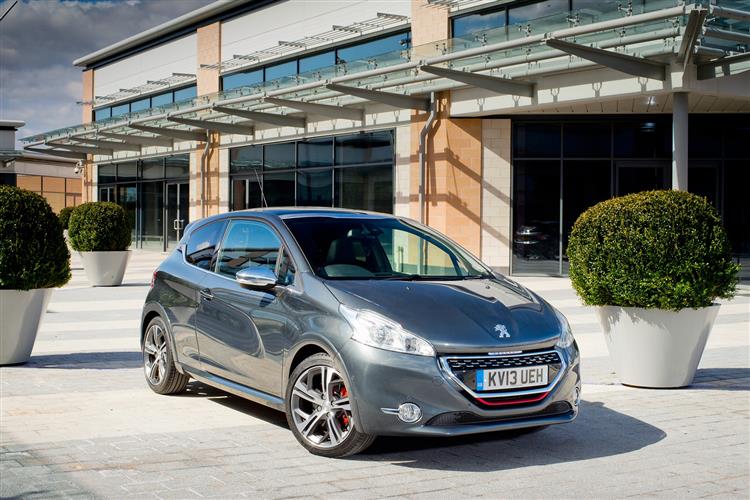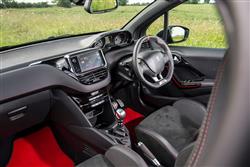MORE LOVE & EIGHT (some text hidden) --NONE--
By Jonathan Crouch
Introductionword count: 90
Back in 2012, while the motoring press may have wanted Peugeot's 208 GTi to be a raw, uncompromising hot hatch, the French brand instead went its own way and brought us something that, though still huge fun, was actually quite a bit more sophisticated than that. A car for people who might remember this model's iconic 205 GTi Eighties predecessor but these days want something that doesn't put them through the wringer in delivering its best, something a bit more grown-up. It's a class act. And an interesting used buy.
Modelsword count: 6
3dr Supermini (Petrol - 1.6 [208hp])
Historyword count: 332
It seems that it's impossible to consider a verdict on Peugeot's 208 GTi without harking back to its legendary predecessor, the 205 GTi we first saw in 1984. Contemporary hot hatch road tests lament the fact that in contrast to that iconic car, modern shopping rockets are too fat, too grippy and too safe, testers getting all dewy-eyed as they reminisce about the time they entered a beet field backwards at 85mph in a 205. Ah, the nostalgia of being out of control, surrounded by metal with the structural integrity of a Sprite can. Nope, we'll take a modern hot hatch any day and put up with a little less mid-corner throttle adjustability in exchange for things like air conditioning, a decent stereo, turbocharged grunt, seats that fit, an engine that can cover big mileages without issue and a dashboard that doesn't twitter like the queue at a One Direction gig. We're silly like that. So though we'll accept that some potential 208 GTi buyers may have had a 205 GTI on their bedroom wall as kids, we're also as sure as Peugeot was at the launch of this car in 2012 that these people these days look for something better built, more comfortable and safer while still delivering excitement when they want it. That last bit is important and very much defines what this car is all about. You might well be able to buy faster supermini-based hot hatches from this period and you can certainly buy ones that deliver a bigger adrenaline rush, but this 208 is a car very much designed to respond to your moods rather than constantly imposing its personality upon you. If you've grown out of being dictated to, you're probably going to like that a lot. There were standard and plusher 'Prestige' models available. Both were facelifted for the 2015 model year, at which point a top 'Peugeot Sport' variant was added in to the top of the range. The 208 GTi sold until 2018.
What You Getword count: 735
List them and the 208 GTi has all the requisite hot hatch design cues but it's not the most instantly pugnacious of shapes. In fact, it's a bit like that movie where Elijah Wood starred as knife wielding football thug - all a bit too cuddly to take entirely seriously. There's a lower ride height and a wider track, plus the front end came in for some styling budget with the halogen headlamps featuring LEDs for the directional indicators and daytime lighting. They're lights that frame a mesh grille with bright chrome inserts and what's claimed to be a '3D chequered flag' effect. There are gently blistered wheel arches housing good-looking 17-inch alloy wheels, while the chromed trim strip at the C pillar tips the hat to the old 205 GTi which, like this car, was only offered in three-door form. The rear end is finished with a gloss black rear skirt from which the exhaust emerges with a trapezoid chromed double tailpipe. Whichever colour you choose for your 208 GTi, there are always red highlights, from the GTi quarter panel to the brake calipers, grille lower bead and in the Peugeot scripts on the tailgate and grille. It's all neatly done, looks agreeably cohesive but isn't going to unduly scare slower, more timid road users when you roar up their rear view mirror. Maybe that's the point. Drop inside, easing yourself into the thickly-bolstered Nappa leather-trimmed red-stitched sports seats, and you're greeted by the 208's trademark low and tiny steering wheel and relatively high seating position. If you've not come across this layout before, the set-up is that instead of peering through a big wheel at the instruments as you would normally do, you view the high-mounted dial pack over the top of the red-stitched leather-trimmed rim of a much smaller wheel. It takes a bit of getting used to and if you want to be able to see the dials, you need to lower the flat-bottomed wheel so it's almost brushing your thighs, so drivers who insist on assuming a semi-reclined, straight armed driving position may find that the wheel rim obscures part of the instrument cluster. Most will find a seating compromise that works though and once you've adjusted to the whole arrangement, you'll probably end up preferring it to something more conventional. Once you've got yourself comfortable, take a look around and you'll find that there's a lot going on here. We're not sure that all of the decor works - the red fade to black on the door handle and the centre console trim is questionable and the aluminium detail on the dash top creates a nasty reflection in the windscreen. Otherwise it's hard not to be impressed by the quality feel in the cabin. And there are plenty of lovely touches: the aluminium pedals, the red-framed instrument cluster and the stitched marker on the steering wheel to indicate the straight ahead position. Drivers' stuff. Button clutter was kept to a minimum too mainly thanks to the provision of what looks like a tablet PC attached to the fascia. The 7” multifunction colour infotainment touch screen offers access to radio, Bluetooth 'phone functions and downloadable apps, plus most early owners paid a few hundred pounds extra to add satellite navigation to it. You'd expect the bulky sports seats to leave rear seat passengers in this three-door-only model a bit squeezed for legroom - which is true, though we should point out that the long-ish wheelbase of this 208 means that back seat folk are better off than they would be in some other rivals - there's 50mm more legroom than, for example, you'd get in a rival Fiesta ST from this period. Headroom for tall rear passengers isn't quite so impressive. The boot isn't bad size at 285-litres, a little less than you'd get in a rival Renaultsport Clio it's true but a pretty decent size compared to the 276-litres you get in a Fiesta ST and the 236-litres you're left with in a SEAT Ibiza Cupra from this time. It's a decently shaped cargo area too, with minimal intrusions and a fairly low loading lip. There's also a 60/40 split rear seat though it doesn't quite fold flat. Still, if you do push it forward, there's a useful 1,076-litres of fresh air to play with across a space wide enough to carry a lot more than you might expect.
To see the full road test text contact us on 0330 0020 227
Pictures (high res disabled)

.jpg)
|
.jpg)
|
.jpg)
| |||
.jpg)
|

|
Scoring (subset of scores)
Category: Sporting Cars
| Performance | |
| Handling | |
| Comfort | |
| Space | |
| Styling, Build, Value, Equipment, Depreciation, Handling, Insurance and Total scores are available with our full data feed. | |



